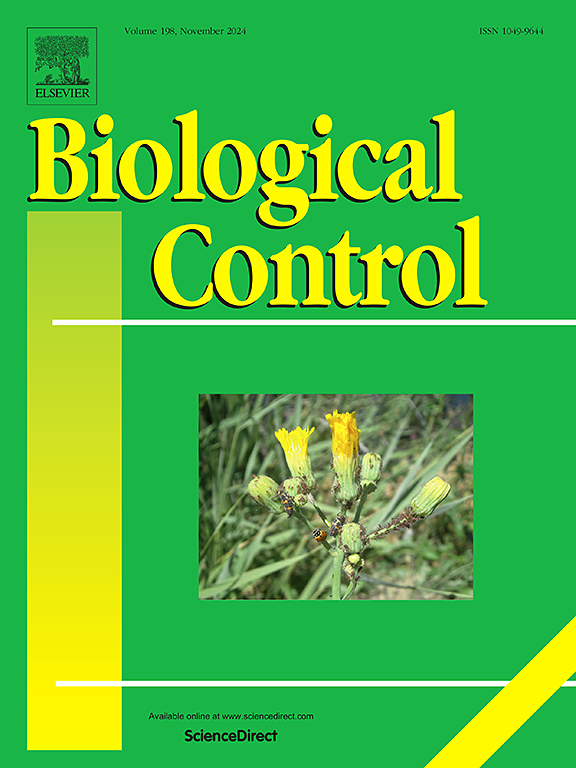水凝胶增强昆虫病原线虫对小桃树螟虫等地上害虫环境耐受性的比较
IF 3.4
2区 农林科学
Q2 BIOTECHNOLOGY & APPLIED MICROBIOLOGY
引用次数: 0
摘要
小桃树螟虫(LPTB;Synanthedon pictipes;(格罗特,罗宾逊];(鳞翅目:绵蚜科)是美国东南部桃子的主要害虫,生长在树皮下,难以用化学杀虫剂控制。昆虫病原线虫(epn),如豆荚斯坦线虫(steinerma carpocapsae),提供了一种潜在的地上生物防治选择,但其有效性受到紫外线暴露和干燥的限制。在这项研究中,我们评估了S. carpocapsae悬浮在五种凝胶处理中的生存(活力)和传染性(毒力),分别是Barricade®、海藻酸钠、羧甲基纤维素(CMC)、黄原胶、刺槐豆胶和水。epn在实验室中暴露于紫外线辐射0、3、6或8小时,或喷洒在桃皮上并暴露在室外条件下长达3小时。暴露后评估EPN对mellonia幼虫的死亡率和毒力。实验结果表明,与合成凝胶Barricade®相比,海藻酸钠和刺槐豆胶对EPN活性的保护作用最大,在紫外线照射60至8小时后,幼虫的死亡率较高。室外实验显示,暴露在树皮表面后,这三种凝胶中的epn比暴露在水、CMC或黄原胶中的epn具有更高的毒力。研究结果支持利用天然水凝胶提高地上环境EPN的恢复力,促进其在桃害虫可持续治理中的应用。未来的研究应探索现场应用,包括优化处理时间和凝胶降解动力学,以优化天然凝胶在针对LPTB幼虫和其他蛀木昆虫的地上处理中保护epn的效果。本文章由计算机程序翻译,如有差异,请以英文原文为准。

Comparison of hydrogels to enhance the environmental tolerance of the entomopathogenic nematode, Steinernema carpocapsae to target aboveground insect pests such as the lesser peachtree borer (Synanthedon pictipes, (Lepidoptera: Sesiidae))
The lesser peachtree borer (LPTB; Synanthedon pictipes; [Grote & Robinson]; (Lepidoptera: Sesiidae) is a key pest of peaches in the southeastern U.S., that develops beneath the bark and is difficult to manage with chemical insecticides. Entomopathogenic nematodes (EPNs) such as Steinernema carpocapsae, offer a potential aboveground biological control option, but their effectiveness is limited by UV exposure and desiccation. In this study, we evaluated the survival (viability) and infectivity (virulence) of S. carpocapsae suspended in five gel treatments, Barricade®, sodium alginate, carboxymethyl cellulose (CMC), xanthan gum, and locust bean gum, as well as water. EPNs were exposed to UV radiation for 0, 3, 6, or 8 h in the laboratory or sprayed onto peach bark and exposed to outdoor conditions for up to three hours. EPN mortality and virulence against Galleria mellonella larvae were assessed post-exposure. Laboratory assays showed that sodium alginate and locust bean gum provided the greatest protection to EPN viability and supported high larval mortality after 6to8 h of UV exposure, comparable to the synthetic gel Barricade®. Outdoor assays revealed that EPNs in these three gels retained higher virulence than those in water, CMC, or xanthan gum after exposure on bark surfaces. Results support the use of natural hydrogels to improve EPN resilience in aboveground environments, promoting their use in sustainable pest management for peach pests. Future research should investigate field applications, including optimal treatment timing and gel degradation dynamics, to optimize natural gels for protecting EPNs in aboveground treatments targeting LPTB larvae and other wood-boring insects.
求助全文
通过发布文献求助,成功后即可免费获取论文全文。
去求助
来源期刊

Biological Control
生物-昆虫学
CiteScore
7.40
自引率
7.10%
发文量
220
审稿时长
63 days
期刊介绍:
Biological control is an environmentally sound and effective means of reducing or mitigating pests and pest effects through the use of natural enemies. The aim of Biological Control is to promote this science and technology through publication of original research articles and reviews of research and theory. The journal devotes a section to reports on biotechnologies dealing with the elucidation and use of genes or gene products for the enhancement of biological control agents.
The journal encompasses biological control of viral, microbial, nematode, insect, mite, weed, and vertebrate pests in agriculture, aquatic, forest, natural resource, stored product, and urban environments. Biological control of arthropod pests of human and domestic animals is also included. Ecological, molecular, and biotechnological approaches to the understanding of biological control are welcome.
 求助内容:
求助内容: 应助结果提醒方式:
应助结果提醒方式:


